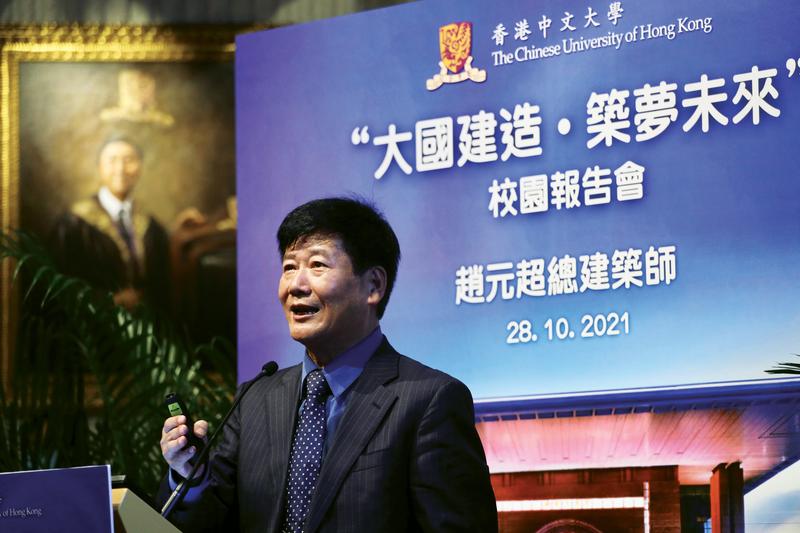 Zhao Yuanchao, chief architect of the China Northwest Architectural Design and Research Institute delivers a lecture on Thursday at the Chinese University of Hong Kong. This was the last lecture given by a delegation of mainland engineering experts at universities in
Hong Kong. (EDMOND TANG / CHINA DAILY)
Zhao Yuanchao, chief architect of the China Northwest Architectural Design and Research Institute delivers a lecture on Thursday at the Chinese University of Hong Kong. This was the last lecture given by a delegation of mainland engineering experts at universities in
Hong Kong. (EDMOND TANG / CHINA DAILY)
A house is built to meet basic needs, while architecture is crafted with enthusiasm and emotion invested in it, carrying historical values and cultural connotations, Zhao Yuanchao, chief architect of the China Northwest Architectural Design and Research Institute, said on Thursday during his lecture at the Chinese University of Hong Kong.
This event wrapped up a four-day lecture tour delivered by members of a delegation of the nation’s leading architecture and engineering experts, who arrived in Hong Kong on Sunday.
Zhao compared architecture built on a stretch of land to characters penned on a sheet of paper. Each stroke an architect uses should speak to the city’s historical and cultural significance, he said.
At the talk, the renowned architect said he appreciated the way the CUHK is built on similarly hilly land and how the buildings on campus capture the historical implications.
“Hong Kong is a good example to follow in terms of finding architectural solutions vertically,” Zhao said. Rampant urban sprawl and growing populations in most Chinese cities necessitate a layered approach in urban design that has been seen in Hong Kong, he said. “We will see the roles of architects and urban planners blurred and integrated.”
One of Zhao’s masterpieces — the Yan’an Grand Theatre in Northwest China’s Shaanxi province — is a case in point. The theater was built on a plot that was originally cave dwellings, where the then Chairman Mao Zedong proverbially compiled On Protracted War and the classic patriotic song The Yellow River Cantata was composed. This historical background sets the tone for the architectural language that should shine through the exterior and interior design, Zhao noted, saying, “Architecture design should pay homage to the history, and be emotionally charged.”
The Chinese feature is juxtaposed with the arch, a Western symbolic architectural element, to make the creation more contemporary and eclectic, Zhao said.
Xi’an is a topographically flat city, steeped in a historical axis from the Han, Tang, Ming, and Qing Dynasties through to modern times. “When we were designing architecture in the city, we tried to preserve its historical relics and cultural heritage, infuse humanistic affection, and elevate it through craftsmanship,” Zhao said.
Celebrated as one of China’s top 100 architects by the Architectural Society of China, Zhao has participated in the design of the library and nature museum of Shaanxi province; the airport and the international convention and exhibition center of Xi’an, the provincial capital of Shaanxi; as well as a tourism industrial garden in Yan’an, a city in Shaanxi steeped in history.
Shaanxi’s mountainous, craggy, and rocky geography poses insurmountable challenges to architectural design and building, Zhao said, before conceding that this can be overcome by “respecting” and “harmonizing with” nature. “Design with no trace detected” is the finest hallmark of architecture, he said, adding that it means to “stay true to the pristine nature” and “align architecture with geography”. Zhao said that he treasures the wildness and masculinity oozing across the province that is known as “yellow earth”, and which “balances the gentleness and tenderness prevailing in Chinese culture”.
Q&A with Zhao
Thank you for sharing that phenomenal landmark architecture in Xi’an. But I realize the distinctive features are not quite compatible with the residential and office buildings in the background. So, how to align these buildings in style or to mitigate the discrepancy?
While we say that architecture serves as a cultural vector, it cannot be overloaded with cultural implications. I always encourage to jianfu, or lighten the burden for buildings.
We have become so obsessed with landmark architecture. But let’s not forget: 80 percent of the buildings in a city serve as offices and homes. Visual shock is pleasant, but it only works when basic human needs are satisfied.
Otherwise, it’s just overkill.
In architecture, quality outweighs innovation and aesthetics, but functionality and comfort trump everything.


